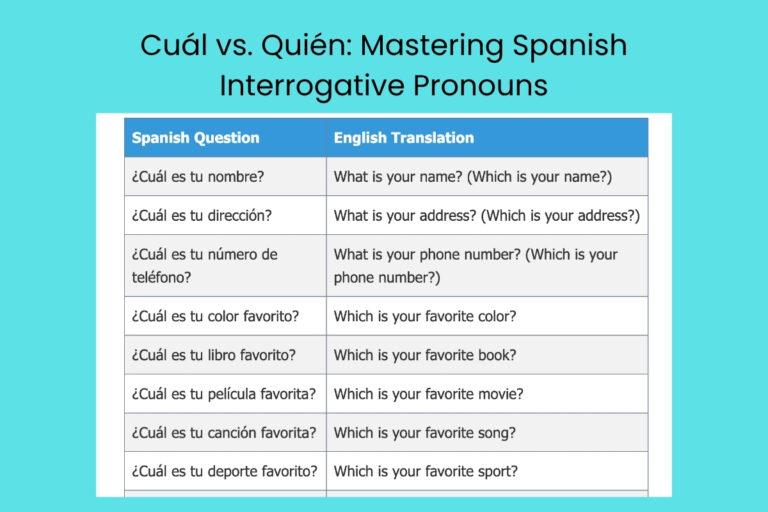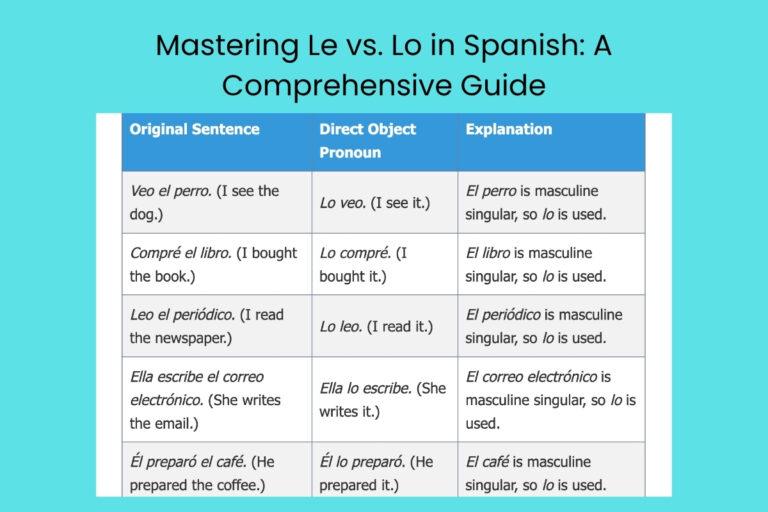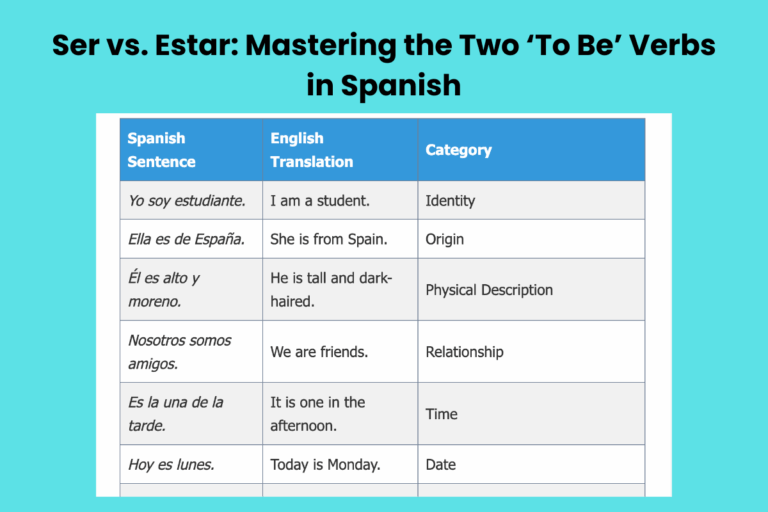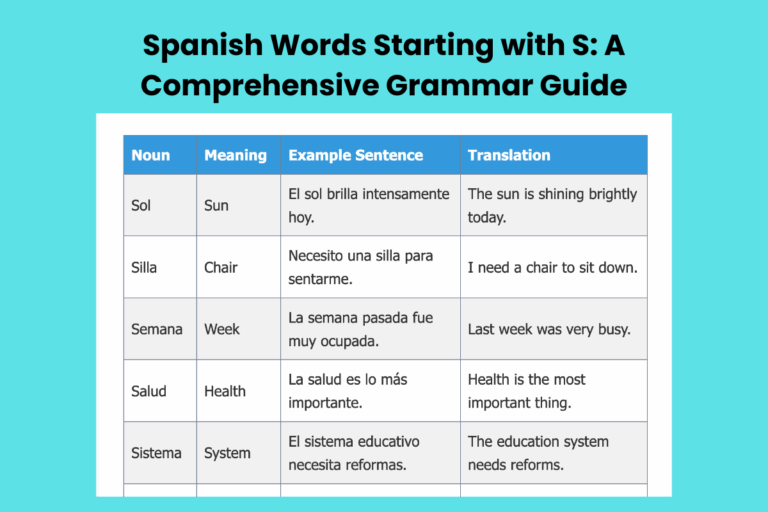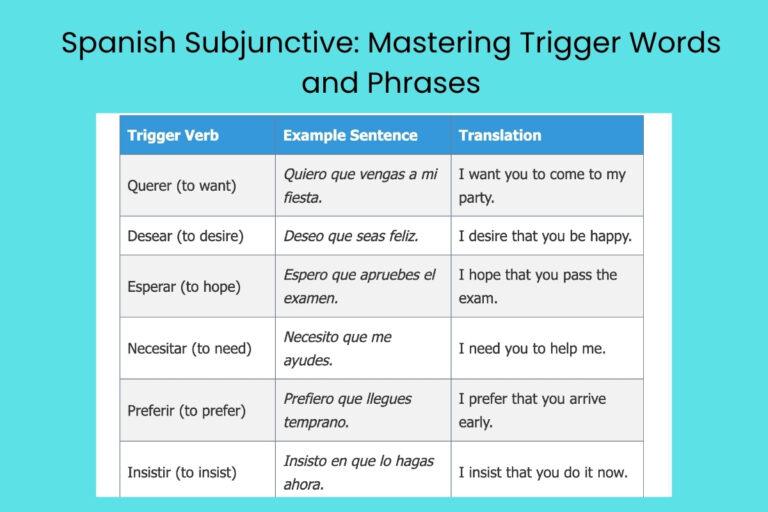Mastering Affirmation: How to Say Yes in Spanish
Saying “yes” might seem simple, but in Spanish, like in any language, there’s nuance and variety. Understanding these nuances is crucial for effective communication and avoiding misunderstandings.
This article delves into the various ways to express affirmation in Spanish, from the basic “sí” to more complex and contextual responses. Mastering these expressions will not only enhance your Spanish fluency but also improve your ability to navigate social and professional situations with confidence.
Whether you’re a beginner or an advanced learner, this guide offers valuable insights and practical examples to help you say “yes” like a native speaker.
This article is designed for anyone learning Spanish, from absolute beginners to advanced speakers looking to refine their understanding of idiomatic expressions. It’s particularly useful for students, travelers, and professionals who interact with Spanish speakers.
By exploring the various ways to express agreement and affirmation, you’ll gain a deeper understanding of Spanish culture and communication styles.
Table of Contents
- Introduction
- Definition of Affirmation in Spanish
- Structural Breakdown of “Sí”
- Types and Categories of Affirmation
- Examples of Affirmation in Spanish
- Usage Rules for Affirmation
- Common Mistakes in Affirmation
- Practice Exercises
- Advanced Topics in Affirmation
- Frequently Asked Questions
- Conclusion
Definition of Affirmation in Spanish
In Spanish, affirmation is the act of expressing agreement, acceptance, or confirmation. The most basic form of affirmation is the word “sí”, which directly translates to “yes” in English. However, affirmation in Spanish extends beyond this simple word, encompassing a variety of expressions and grammatical structures used to convey different degrees of agreement and certainty. Understanding these nuances is essential for effective communication and avoiding misunderstandings. Affirmation can be expressed through single words, phrases, or even entire sentences, depending on the context and the speaker’s intent. The choice of expression often depends on the level of formality, the relationship between the speakers, and the specific situation.
Affirmation serves multiple functions in Spanish conversation. It can be used to answer questions positively, confirm statements, express agreement with opinions, or even emphasize a point.
The way affirmation is expressed can also convey the speaker’s attitude, such as enthusiasm, reluctance, or indifference. For example, a simple “sí” might indicate basic agreement, while an emphatic “¡Claro que sí!” expresses strong affirmation.
Therefore, mastering the various forms of affirmation is crucial for conveying your intended meaning accurately and effectively in Spanish.
Structural Breakdown of “Sí”
The word “sí” in Spanish is a monosyllabic word consisting of the letter “s” followed by the vowel “í”. The acute accent mark on the “í” is crucial because it distinguishes “sí” (yes) from “si” (if). This accent mark indicates that the vowel should be stressed and ensures that the word is pronounced correctly and understood in its intended meaning. Without the accent, the word changes its meaning entirely, highlighting the importance of proper spelling in Spanish. The pronunciation of “sí” is straightforward, with a clear and concise sound that emphasizes the affirmation. Understanding this basic structural element is the foundation for mastering more complex forms of affirmation in Spanish.
The structural simplicity of “sí” belies its versatility. It can stand alone as a complete response to a question or be incorporated into longer phrases to express varying degrees of agreement.
For example, you can add adverbs or qualifiers to “sí” to make your affirmation more emphatic or specific. The intonation used when pronouncing “sí” can also significantly alter its meaning.
A rising intonation might indicate a question or uncertainty, while a falling intonation conveys confidence and certainty. Therefore, while the structure of “sí” is simple, its usage and interpretation require careful attention to context and intonation.
Types and Categories of Affirmation
Affirmation in Spanish is not limited to a single word. It encompasses a range of expressions that vary in intensity, formality, and context.
Here’s a breakdown of the different types and categories of affirmation in Spanish:
Basic “Sí”
The most fundamental form of affirmation is the simple word “sí”. It is used to directly answer a question in the affirmative or to indicate agreement with a statement. It’s versatile and can be used in almost any context, making it the go-to option for expressing basic affirmation.
Affirmative Responses to Questions
This category includes responses that directly answer a question with a positive confirmation. These responses often incorporate “sí” but can also include additional information to provide a more complete answer.
For example, instead of just saying “sí,” you might say “Sí, lo haré” (Yes, I will do it).
Statements of Agreement
These are phrases used to express agreement with someone’s opinion or statement. They go beyond a simple “sí” to show that you share the same viewpoint.
Examples include “Estoy de acuerdo” (I agree) and “Tienes razón” (You’re right).
Emphatic Affirmation
When you want to express strong agreement or conviction, you can use emphatic affirmations. These expressions add intensity to your “yes” and leave no room for doubt.
Common examples include “¡Claro que sí!” (Of course!) and “¡Por supuesto!” (Absolutely!).
Conditional Affirmation
Sometimes, your agreement might depend on certain conditions. Conditional affirmations express agreement that is contingent on specific circumstances.
For instance, you might say “Sí, si tengo tiempo” (Yes, if I have time).
Idiomatic Expressions of Agreement
Spanish is rich in idiomatic expressions that convey agreement in colorful and expressive ways. These expressions often have cultural significance and can add a unique flavor to your speech.
Examples include “¡Ni que lo digas!” (You can say that again!) and “¡Eso sí!” (That’s for sure!).
Examples of Affirmation in Spanish
To fully understand the different types of affirmation in Spanish, it’s helpful to see them in action. Here are several examples organized by category:
Basic “Sí” Examples
The following table illustrates the use of the basic “sí” in various contexts. This is the most straightforward way to say “yes” and is suitable for almost any situation.
| Spanish | English |
|---|---|
| ¿Quieres café? Sí. | Do you want coffee? Yes. |
| ¿Estás listo? Sí. | Are you ready? Yes. |
| ¿Entiendes? Sí. | Do you understand? Yes. |
| ¿Te gusta la película? Sí. | Do you like the movie? Yes. |
| ¿Vas a venir? Sí. | Are you coming? Yes. |
| ¿Hablaste con Juan? Sí. | Did you talk to Juan? Yes. |
| ¿Terminaste el trabajo? Sí. | Did you finish the work? Yes. |
| ¿Tienes hambre? Sí. | Are you hungry? Yes. |
| ¿Estás cansado? Sí. | Are you tired? Yes. |
| ¿Quieres ir al cine? Sí. | Do you want to go to the cinema? Yes. |
| ¿Sabes la respuesta? Sí. | Do you know the answer? Yes. |
| ¿Puedes ayudarme? Sí. | Can you help me? Yes. |
| ¿Estudiaste para el examen? Sí. | Did you study for the exam? Yes. |
| ¿Te gusta el helado? Sí. | Do you like ice cream? Yes. |
| ¿Visitaste a tus padres? Sí. | Did you visit your parents? Yes. |
| ¿Compraste el libro? Sí. | Did you buy the book? Yes. |
| ¿Viste el partido? Sí. | Did you watch the game? Yes. |
| ¿Hiciste la tarea? Sí. | Did you do the homework? Yes. |
| ¿Tienes frío? Sí. | Are you cold? Yes. |
| ¿Quieres un vaso de agua? Sí. | Do you want a glass of water? Yes. |
Question Response Examples
This table provides examples of affirmative responses to questions, including additional information to provide a more complete answer. Notice how the “sí” is often followed by a clause that elaborates on the affirmation.
| Spanish | English |
|---|---|
| ¿Vas a ir a la fiesta? Sí, voy a ir. | Are you going to the party? Yes, I am going. |
| ¿Puedes ayudarme con esto? Sí, puedo ayudarte. | Can you help me with this? Yes, I can help you. |
| ¿Terminaste el informe? Sí, ya lo terminé. | Did you finish the report? Yes, I already finished it. |
| ¿Te gusta la música? Sí, me gusta mucho. | Do you like the music? Yes, I like it a lot. |
| ¿Quieres venir con nosotros? Sí, quiero venir. | Do you want to come with us? Yes, I want to come. |
| ¿Estudias español? Sí, estudio español. | Do you study Spanish? Yes, I study Spanish. |
| ¿Trabajas aquí? Sí, trabajo aquí. | Do you work here? Yes, I work here. |
| ¿Comprendes la lección? Sí, comprendo la lección. | Do you understand the lesson? Yes, I understand the lesson. |
| ¿Tienes tiempo mañana? Sí, tengo tiempo mañana. | Do you have time tomorrow? Yes, I have time tomorrow. |
| ¿Quieres comer algo? Sí, quiero comer algo. | Do you want to eat something? Yes, I want to eat something. |
| ¿Necesitas ayuda? Sí, necesito ayuda. | Do you need help? Yes, I need help. |
| ¿Vas a viajar este año? Sí, voy a viajar este año. | Are you going to travel this year? Yes, I am going to travel this year. |
| ¿Cocinas bien? Sí, cocino bien. | Do you cook well? Yes, I cook well. |
| ¿Cantas en la ducha? Sí, canto en la ducha. | Do you sing in the shower? Yes, I sing in the shower. |
| ¿Lees mucho? Sí, leo mucho. | Do you read a lot? Yes, I read a lot. |
| ¿Escribes poemas? Sí, escribo poemas. | Do you write poems? Yes, I write poems. |
| ¿Juegas al fútbol? Sí, juego al fútbol. | Do you play soccer? Yes, I play soccer. |
| ¿Nadas en el mar? Sí, nado en el mar. | Do you swim in the sea? Yes, I swim in the sea. |
| ¿Corres por las mañanas? Sí, corro por las mañanas. | Do you run in the mornings? Yes, I run in the mornings. |
| ¿Bailas salsa? Sí, bailo salsa. | Do you dance salsa? Yes, I dance salsa. |
| ¿Pintas cuadros? Sí, pinto cuadros. | Do you paint pictures? Yes, I paint pictures. |
Agreement Statement Examples
The following table showcases statements of agreement, which go beyond a simple “sí” to show that you share the same viewpoint. These phrases are useful for expressing solidarity and understanding.
| Spanish | English |
|---|---|
| Creo que es una buena idea. Estoy de acuerdo. | I think it’s a good idea. I agree. |
| Esta película es increíble. Tienes razón. | This movie is incredible. You’re right. |
| Deberíamos irnos ahora. Me parece bien. | We should leave now. That sounds good to me. |
| El clima está muy agradable hoy. Es verdad. | The weather is very nice today. That’s true. |
| Necesitamos más tiempo. Eso es cierto. | We need more time. That’s right. |
| Es importante ser puntual. Sin duda. | It’s important to be punctual. Without a doubt. |
| Este libro es muy interesante. Lo creo. | This book is very interesting. I believe so. |
| La situación es complicada. Así es. | The situation is complicated. That’s how it is. |
| Es necesario estudiar más. Exacto. | It’s necessary to study more. Exactly. |
| El café está delicioso. En efecto. | The coffee is delicious. Indeed. |
| Es un buen plan. De acuerdo. | It’s a good plan. Agreed. |
| Debemos ser más pacientes. Tienes toda la razón. | We must be more patient. You are absolutely right. |
| El problema es grave. Ciertamente. | The problem is serious. Certainly. |
| Es fundamental ser honesto. Por supuesto. | It is essential to be honest. Of course. |
| Necesitamos cambiar la estrategia. Indudablemente. | We need to change the strategy. Undoubtedly. |
| Es crucial trabajar en equipo. Claro que sí. | It is crucial to work as a team. Of course. |
| El esfuerzo vale la pena. Absolutamente. | The effort is worth it. Absolutely. |
| Es esencial ser respetuoso. Evidentemente. | It is essential to be respectful. Evidently. |
| Debemos ser más considerados. Totalmente. | We must be more considerate. Totally. |
| Es importante ser agradecido. Verdaderamente. | It is important to be grateful. Truly. |
| Es necesario ser perseverante. Seguramente. | It is necessary to be perseverant. Surely. |
Emphatic Affirmation Examples
This table provides examples of emphatic affirmations, which add intensity to your “yes” and leave no room for doubt. These are perfect for expressing strong conviction.
| Spanish | English |
|---|---|
| ¿Estás seguro? ¡Claro que sí! | Are you sure? Of course! |
| ¿Vendrás a la fiesta? ¡Por supuesto! | Will you come to the party? Absolutely! |
| ¿Confías en mí? ¡Desde luego! | Do you trust me? Certainly! |
| ¿Te gusta la comida? ¡Muchísimo! | Do you like the food? Very much! |
| ¿Quieres ir de vacaciones? ¡Definitivamente! | Do you want to go on vacation? Definitely! |
| ¿Crees que ganaremos? ¡Seguro que sí! | Do you think we will win? I’m sure we will! |
| ¿Estás emocionado? ¡Totalmente! | Are you excited? Totally! |
| ¿Lo harás bien? ¡Sin duda alguna! | Will you do it well? Without a doubt! |
| ¿Es importante? ¡Sumamente! | Is it important? Extremely! |
| ¿Estás de acuerdo? ¡Completamente! | Do you agree? Completely! |
| ¿Es necesario? ¡Absolutamente! | Is it necessary? Absolutely! |
| ¿Estás preparado? ¡Por supuesto que sí! | Are you prepared? Of course I am! |
| ¿Lo entiendes? ¡Perfectamente! | Do you understand it? Perfectly! |
| ¿Estás convencido? ¡Plenamente! | Are you convinced? Fully! |
| ¿Es verdad? ¡Verdaderamente! | Is it true? Truly! |
| ¿Estás conforme? ¡Enteramente! | Are you satisfied? Entirely! |
| ¿Es posible? ¡Indudablemente! | Is it possible? Undoubtedly! |
| ¿Estás seguro de esto? ¡Completamente seguro! | Are you sure about this? Completely sure! |
| ¿Lo recomiendas? ¡Altamente! | Do you recommend it? Highly! |
| ¿Estás feliz? ¡Inmensamente! | Are you happy? Immensely! |
Idiomatic Affirmation Examples
The following table provides examples of idiomatic expressions of agreement, which add a unique flavor to your speech and often have cultural significance.
| Spanish | English |
|---|---|
| Es muy caro. ¡Ni que lo digas! | It’s very expensive. You can say that again! |
| Hace mucho calor. ¡Eso sí! | It’s very hot. That’s for sure! |
| Es un gran jugador. ¡Qué va! (expressing strong agreement) | He is a great player. Absolutely! |
| Necesitamos un descanso. ¡Dalo por hecho! | We need a break. Consider it done! |
| Es una buena idea. ¡No me digas! (sarcastic agreement, be careful with tone) | It’s a good idea. You don’t say! |
| Es hora de irnos. ¡Manos a la obra! (Let’s get to work!) | It’s time to leave. Let’s get to it! |
| Este trabajo es difícil. ¡Y tanto! | This job is difficult. You can say that again! |
| Es muy importante. ¡A huevo! (Mexico, very informal) | It’s very important. Absolutely! |
| ¿Estás cansado? ¡Un huevo! (Spain, very informal) | Are you tired? Very much so! |
| Es una locura. ¡Qué barbaridad! | It’s crazy. How outrageous! |
| Es muy aburrido. ¡Qué rollo! (Mexico) | It’s very boring. What a drag! |
| Es una ganga. ¡Está tirado! | It’s a bargain. It’s a steal! |
| Es un desastre. ¡Qué pena! | It’s a disaster. What a pity! |
| Es un alivio. ¡Menos mal! | It’s a relief. Thank goodness! |
| Es una maravilla. ¡Qué gozada! | It’s wonderful. What a joy! |
| Es muy complicado. ¡Vaya tela! (Spain) | It’s very complicated. What a mess! |
| Es muy fácil. ¡Pan comido! | It’s very easy. Piece of cake! |
| Es muy tarde. ¡A buenas horas! (sarcastic) | It’s very late. Just the right time! (sarcastic) |
| Es muy bonito. ¡Qué chulo! (Spain) | It’s very nice. How cool! |
| Es muy divertido. ¡Qué risa! | It’s very funny. What a laugh! |
Usage Rules for Affirmation
While saying “yes” in Spanish might seem straightforward, there are several usage rules to keep in mind to ensure you’re communicating effectively and appropriately.
“Sí” vs. “Que” in Responses
One common mistake is confusing “sí” (yes) with “que” (that). While “sí” is used for direct affirmation, “que” is often used in responses to express agreement or confirmation in a more conversational way. For example, if someone says “Hace frío” (It’s cold), you might respond with “Sí, que frío” (Yes, it’s cold) to emphasize your agreement.
Using Affirmative Adverbs
Spanish has several adverbs that can be used to strengthen or modify your affirmation. Adverbs like “ciertamente” (certainly), “seguramente” (surely), and “verdaderamente” (truly) can add emphasis to your “sí” and convey a stronger sense of agreement. These adverbs are particularly useful in formal settings or when you want to express a high degree of certainty.
Formal vs. Informal Affirmation
The level of formality in your affirmation should match the context of the conversation and your relationship with the other person. In formal settings, it’s best to use more polite and elaborate expressions of agreement, such as “Estoy de acuerdo” (I agree) or “Considero que sí” (I consider that yes).
In informal settings, you can use more casual expressions like “¡Claro que sí!” (Of course!) or even slang terms, depending on your familiarity with the other person and the local culture.
Common Mistakes in Affirmation
Even experienced Spanish learners can make mistakes when expressing affirmation. Here are some common errors to watch out for:
- Forgetting the accent on “sí”: Writing “si” instead of “sí” changes the meaning to “if.”
- Using “que” instead of “sí” incorrectly: Overusing “que” as a replacement for “sí” can sound unnatural.
- Using overly formal expressions in informal settings: This can make you sound stiff or pretentious.
- Using slang inappropriately: Using slang terms without understanding their context or connotations can be offensive or confusing.
Here are some examples of correct and incorrect usages:
| Incorrect | Correct | Explanation |
|---|---|---|
| Si, voy a ir. | Sí, voy a ir. | The accent mark is essential to distinguish “sí” (yes) from “si” (if). |
| ¿Tienes frío? Que. | ¿Tienes frío? Sí. | “Que” cannot be used as a direct replacement for “sí” in this context. |
| Estoy de acuerdo, tío. (Formal setting) | Estoy de acuerdo. (Formal setting) | “Tío” is a slang term that is inappropriate in formal settings. |
| ¿Entiendes? A huevo. (Speaking to your boss) | ¿Entiendes? Sí, entiendo. (Speaking to your boss) | “A huevo” is a very informal and potentially offensive expression to use with a superior. |
Practice Exercises
Test your understanding of affirmation in Spanish with these practice exercises. Each exercise focuses on a different aspect of affirmation, from basic “sí” to more complex expressions of agreement.
-
Exercise 1: Basic Affirmation
Answer the following questions with a simple “sí”.
Question Answer ¿Hablas español? Sí. ¿Estás aprendiendo? Sí. ¿Te gusta la clase? Sí. ¿Tienes preguntas? Sí. ¿Estás listo para empezar? Sí. ¿Entiendes la tarea? Sí. ¿Quieres practicar más? Sí. ¿Estás cansado hoy? Sí. ¿Quieres un café? Sí. ¿Estás de acuerdo? Sí. -
Exercise 2: Question Response
Answer the following questions with an affirmative response that includes additional information.
Question Answer ¿Vas a estudiar esta noche? Sí, voy a estudiar esta noche. ¿Puedes ayudarme mañana? Sí, puedo ayudarte mañana. ¿Terminaste el proyecto? Sí, ya terminé el proyecto. ¿Te gusta el chocolate? Sí, me gusta mucho el chocolate. ¿Quieres ir al cine conmigo? Sí, quiero ir al cine contigo. ¿Necesitas algo de la tienda? Sí, necesito algo de la tienda. ¿Quieres comer algo ahora? Sí, quiero comer algo ahora. ¿Vas a viajar este verano? Sí, voy a viajar este verano. ¿Quieres aprender a bailar salsa? Sí, quiero aprender a bailar salsa. ¿Estás emocionado por las vacaciones? Sí, estoy emocionado por las vacaciones. -
Exercise 3: Agreement Statements
Respond to the following statements with an appropriate statement of agreement.
Statement Answer Es importante ser honesto. Estoy de acuerdo. Esta película es muy buena. Tienes razón. Necesitamos trabajar más duro. Es verdad. El clima está muy frío hoy. Eso es cierto. Es necesario ahorrar dinero. Sin duda. Es crucial ser puntual. Lo creo. La situación es muy difícil. Así es. Es fundamental estudiar idiomas. Exacto. El café está muy caliente. En efecto. Es un buen restaurante. De acuerdo. -
Exercise 4: Emphatic Affirmation
Respond to the following questions with an emphatic affirmation.
Question Answer ¿Estás seguro de esto? ¡Claro que sí! ¿Vendrás a mi fiesta? ¡Por supuesto! ¿Confías en mi palabra? ¡Desde luego! ¿Te gusta la música latina? ¡Muchísimo! ¿Quieres viajar por el mundo? ¡Definitivamente! ¿Crees en el amor verdadero? ¡Seguro que sí! ¿Estás emocionado por el concierto? ¡Totalmente! ¿Lo harás lo mejor posible? ¡Sin duda alguna! ¿Es importante para ti? ¡Sumamente! ¿Estás de acuerdo con mi plan? ¡Completamente!
Advanced Topics in Affirmation
For advanced learners, there are more complex aspects of affirmation to explore, including the subjunctive mood and regional nuances.
Affirmation with the Subjunctive Mood
In certain contexts, affirmation can involve the subjunctive mood, particularly when expressing doubt or uncertainty. For example, you might say “No creo que sí” (I don’t think so), using the subjunctive “sea” instead of the indicative “es” to express your doubt.
Understanding when to use the subjunctive in affirmative statements is a key skill for advanced Spanish learners.
Nuances in Regional Affirmation
Spanish is a diverse language with regional variations in vocabulary and expression. The way affirmation is expressed can vary significantly from
country to country.
For example, in some Latin American countries, you might hear “¡Dale!” used as an affirmative response, while in Spain, “¡Vale!” is more common. Being aware of these regional nuances can help you communicate more effectively and avoid misunderstandings.
Frequently Asked Questions
Conclusion
Mastering affirmation in Spanish involves more than just learning the word “sí.” It requires understanding the nuances of context, formality, and regional variations. By exploring the different types of affirmation, practicing with examples, and avoiding common mistakes, you can confidently express agreement and confirmation in a variety of situations.
Whether you’re a beginner or an advanced learner, the key is to practice regularly and pay attention to how native speakers use affirmation in their daily conversations. With dedication and effort, you can say “yes” like a pro and communicate more effectively in Spanish.


